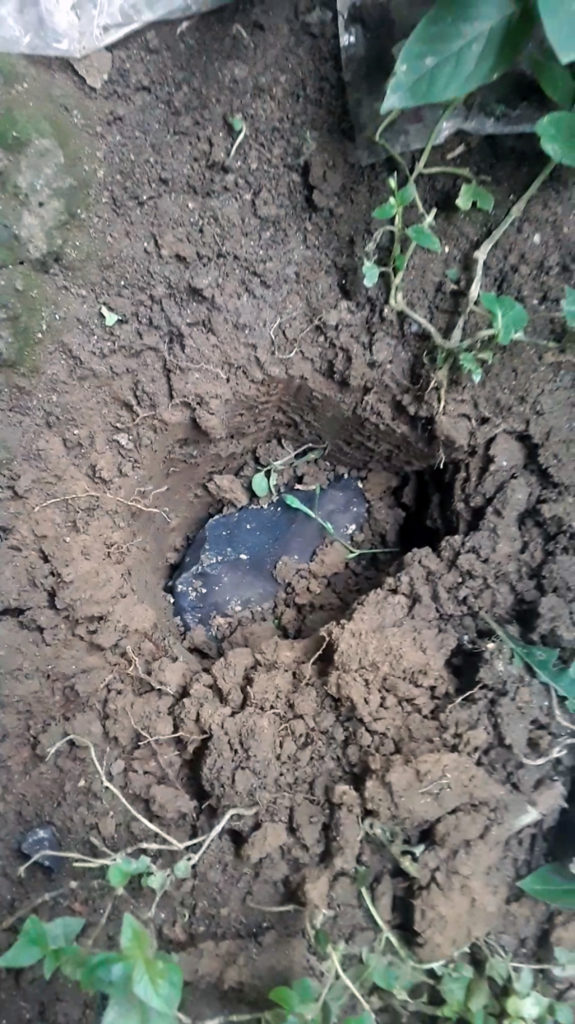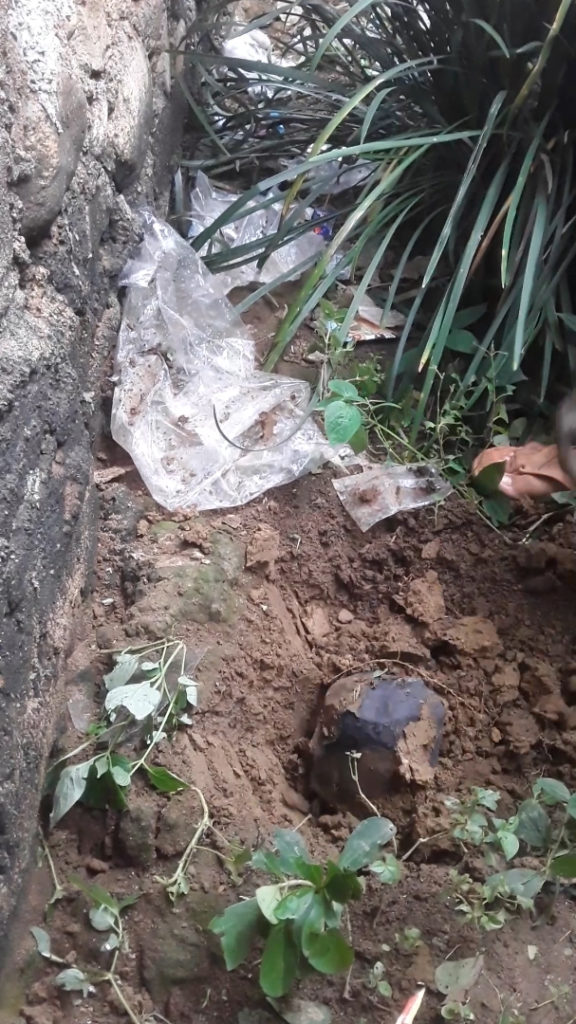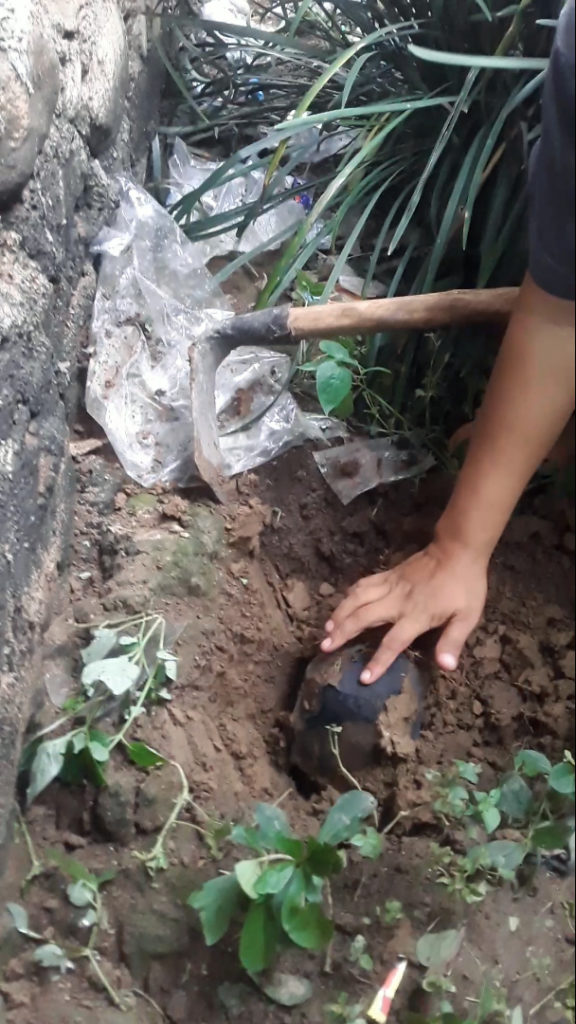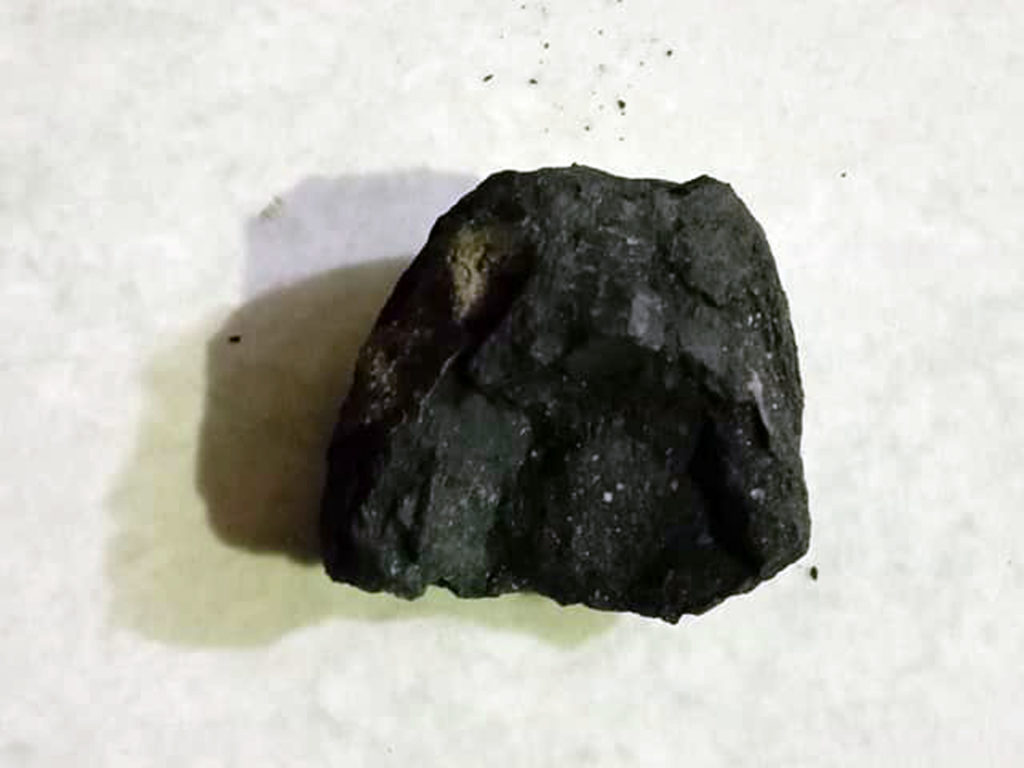KOLANG meteorite fall (CM1/2, ~2.75 kg) in Sitahan Barat, Pasar Onan Hurlang, and Satahi Nauli area, Kolang, Central Tapanuli Regency (Tapanuli Tengah), North Sumatra (Sumatra Utara), Indonesia at ~ 16.40 WIB (9.40 a.m. UTC) on 1 August 2020
Last update: 6 March 2021
A rare meteorite, the most aqueously altered witnessed CM fall (CM1/2) so far, weighing ~2.4 kilograms fell through the zinc roof of 33-year old coffin-maker Josua Hutagalung’s house in the hamlet Sitahan Barat of Pasar Onan Hurlang in the Kolang subdistrict in Central Tapanuli Regency (Tapanuli Tengah), North Sumatra (Sumatra Utara) in Indonesia on 1 August at around 4:40 p.m. West Indonesia Time (9:40 a.m. UTC). The air temperature was about 30° C, the air humidity around 80% and the surface wind (17 km/h) came from northeast at the time of the fall. A woman from Pantai Binasi, Sorkam, is reported to have seen the bright red bolide coming from the direction of Sibolga and moving towards Kolang. Witnesses from the subdistricts Pinangsori and Sibabangun reported that the detonation boom shook their houses. According to Hutagalung’s own account, some time after 4 p.m. he interrupted his work on a coffin at the back of his house to have a coffee break there. He made some coffee and waited for it to cool down. Then, some time after about 4.30 p.m., while drinking the coffee he heard the bolide’s deep rumbling and detonation sounds (like a ‘big boulder being dumped by a dump truck’) in the partly overcast sky. It did not shake houses in Hutagalung’s village and was not very strong. He then smoked a cigarette and went on working on the coffin. Through the noise of the woodworking machine he was using he heard something crash into the roof, similar to the sound of a tree falling on it. This probably happened around 4.40 p.m.. He stopped his work and tried to find something which could have caused the sound, but in vain. Then, after about another 30 minutes, while preparing to have a bath, he was still wondering about the sound he had heard and went to have another look outside. Then he saw the hole in the roof overhang on the western side of the house, near the wall of the living room, and then found the meteorite in its impact pit. He went inside to get his phone and told his family to come and have a look. He started his video recording of the recovery of the meteorite at 5.28 p.m.. The exact fall site had initially not been published but according to our own research the fall happened at this location: 1°53’18.8″N 98°39’39.6″E . The meteorite left an impact pit with a depth of about 15 to 20 centimeters in the soft soil. The two missing pieces of the zinc roof were found right next to the impact pit. According to Hutagalung’s own measurements of the horizontal and vertical distances between the impact hole in the roof and the impact pit in the ground Elang Erlangga calculated that the meteorite seems to have impacted at an angle of about 79° to the horizontal with an azimuth of about 330°. After digging out the meteorite with a hoe about 40 to 50 minutes after the fall Hutagalung’s wife Mardiani Hutabarat was the first to touch and hold it in her hands while their two boys were watching. According to her it was still warm at that time. Next to the main mass of the meteorite about 200 grams of fragments were found in and around the impact pit. Hutagalung’s wife then carried the meteorite to the front of the house and then they kept it in their home for four hours and the meteorite still felt warm during that time. Without the smaller fragments which broke off the main mass alone weighs about 2.1 to 2.2 kilograms. The small fragments of the meteorite are attracted to a magnet. In the afternoon of 3 August Hutagalung told the media about his find. According to Hutagalung one of his sons told him “Jangan dijual, pak!” [Don’t sell it, Sir!] which had initially increased his conviction not to sell the entire meteorite mass. He knew it is very rare and it might bring good luck to his family, since ‘it did not hurt anyone when it fell’. He believed that the meteorite, as a sign of good fortune for his family and his village, might help him to fulfill his deep wish of having a daughter in the future. A few days after the fall Hutagalung sold a 94.2-gram broken off fragment of his meteorite which was immediately exported. By 14 August 2020 at the latest a few bigger and several smaller fragments of other found specimens of this fall had been sold and exported. By mid-August 2020 Hutagalung changed his mind concerning the remaining main mass (1843 g) and sold it entirely to three meteorite dealers who immediately resold it to a collector. Another meteorite fell into a rice field at location 1°53’0.9852″N, 98°39’58.2264″E in the Satahi Nauli village area, 793 metres southeast from Hutagalung’s house. The meteorite broke into many fragments (see video below) while being dug out of the muddy soil. Additionally, a few other finds have inofficially been reported. Two fragments of a 28.15-gram specimens have been found by a family at location 1°50’0.5208″N, 98°41’28.9464″E, 6960 metres southeast to south from the fall site of the 2.4-kg mass. So far only three specimens have apparently been recorded. We hope that the meteorite’s remaining main mass will be properly curated so that it remains available to scientists in the future. Some exported meteorite fragments have been analysed and classified by Laurence Garvie at the Arizona State University (ASU) and Karen Ziegler at the University of New Mexico (UNM). On 28 September the fall was officially added to the Meteoritical Bulletin database as Kolang (CM 1/2).

The known masses and fall locations of the Kolang meteorite fall (up is north). The distance between the fall site of the 2.4-kg mass and the 28.15- gram mass is 6960 metres (azimuth 150°). The distance between the fall site of the 2.4-kg mass and the fall site of the mass from the rice field is 793 metres. Image: karmaka
“Baru 30 menit yang lalu, guys, sekarang kita gali dulu” (Josua Hutagalung). Video recorded by Josua Hutagalung on 1 August (17:28 WIB)
The 2.4-kilogram meteorite at its fall location below the roof. The video was filmed by Mr Josua Hutagalung about 40 to 50 minutes after the fall of the meteorite and shows Mrs Mardiani Hutabarat about to dig it out with a hoe in the presence of her children. Video: Josua Hutagalung (1 August 2020)
The meteorite in situ at its impact site at 5.28 p.m. on 1 August, just before it was excavated with a hoe. Up is southeast. Image: Josua Hutagalung

The meteorite, moments after its removal from the impact pit. Image: Josua Hutagalung

The soil-covered 2.2-kilogram meteorite and some smaller fragments. Photo: Josua Hutagalung

The regmaglypted 2.2-kilogram main mass meteorite. Photo: Josua Hutagalung
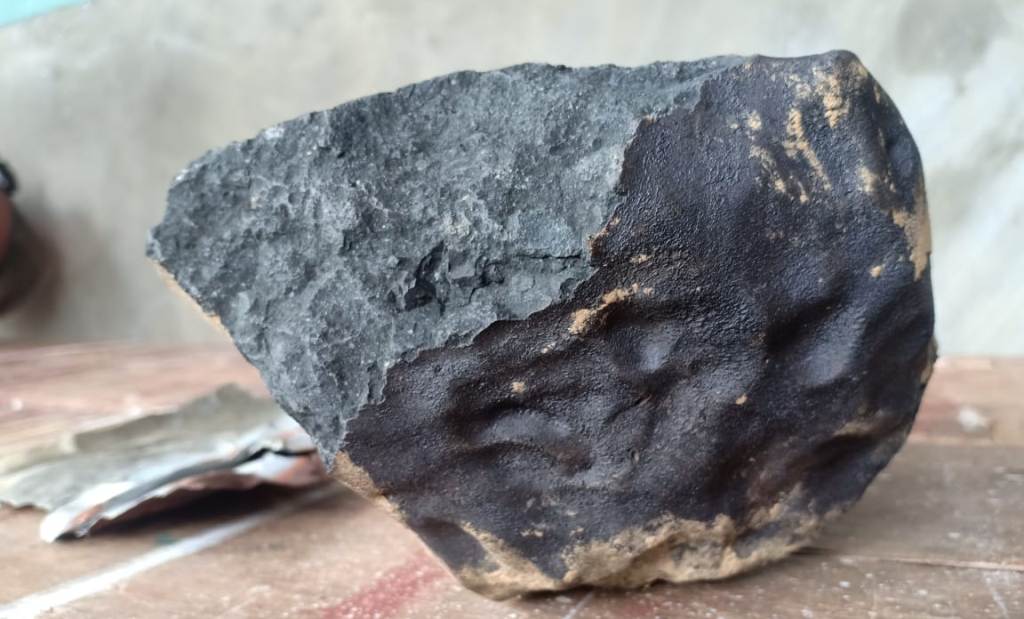
Dark carbonaceous chondrite lithology and fusion crust with regmaglypts. Photo: Smart News Tapanuli

The broken face of the main mass reveals the typical lithology of a carbonaceous chondrite (CM). Photo: iNews TV/Raymond

The impacted upper side of the broken off roof fragment (left) held right above its find location just next to the impact pit. The meteorite (right) with its large flat side facing the sky, as it was originally found. On 3 August it was put back into its impact pit for a reenactment. Image: thomsonpasaribu
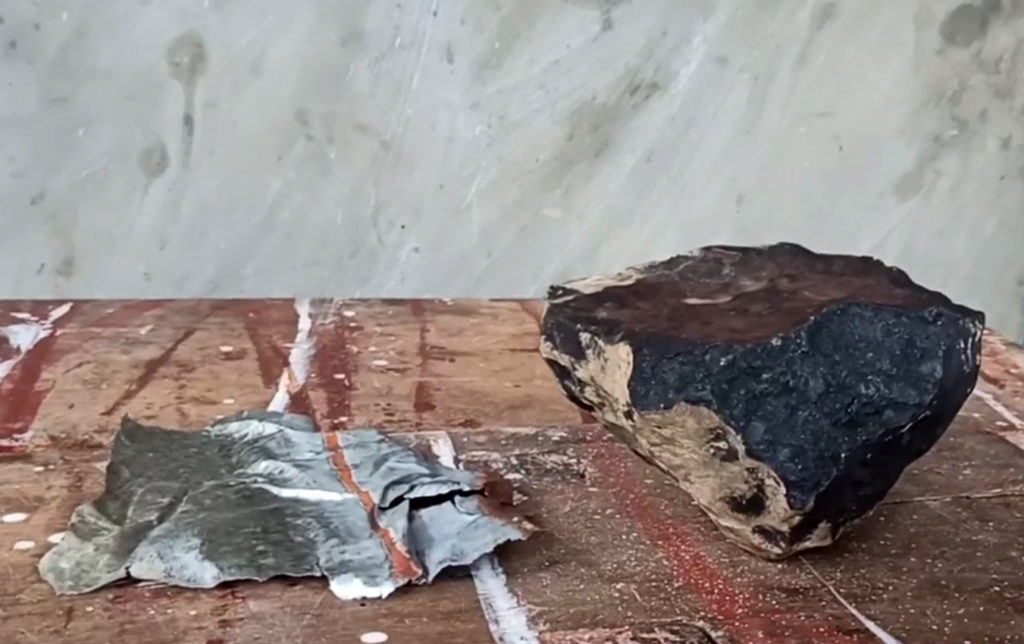
The impacted bottom side of one of the two broken off roof fragment (left) next to the meteorite (right) on 3 August. Image: thomsonpasaribu

The impacted upper side of one of the two broken roof fragments (left). The meteorite’s main mass weighs about 2.1 to 2.2 kilograms on 3 August 2020. Image: thomsonpasaribu

Top view of the loaf-shaped meteorite which is mostly fusion-crusted and has several regmaglypts. Photo: Cindy Astri Nainggolan (5 August 2020)
The meteorite being inspected in Josua Hutagalung’s living room close to the impact hole in the roof on 5 August 2020. Video: unknown
The meteorite being inspected in Josua Hutagalung’s living room close to the impact hole in the roof. Video: unknown
The meteorite being inspected in Josua Hutagalung’s living room close to the impact hole in the roof on 5 August 2020. Video: NKRI
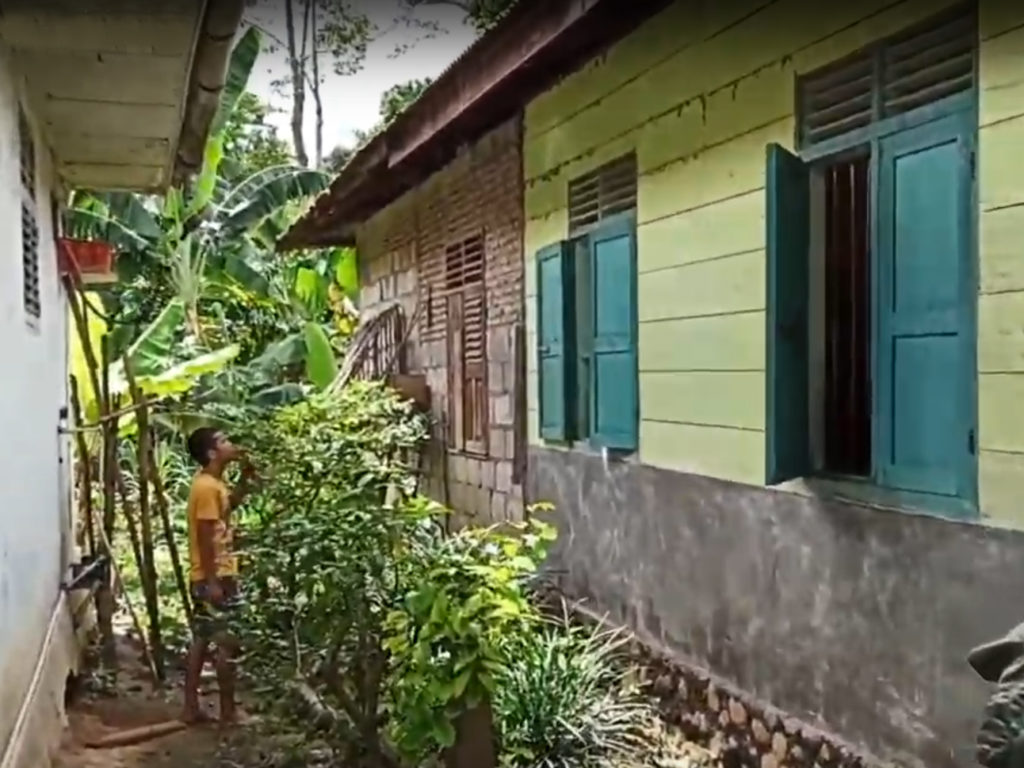
Josua Hutagalung looking at the impact hole in his roof next to the northwestern corner of his living room on 3 August 2020. Image: thomsonpasaribu

The impact hole in the the roof overhang next to the northwestern corner of his living room. Image: thomsonpasaribu
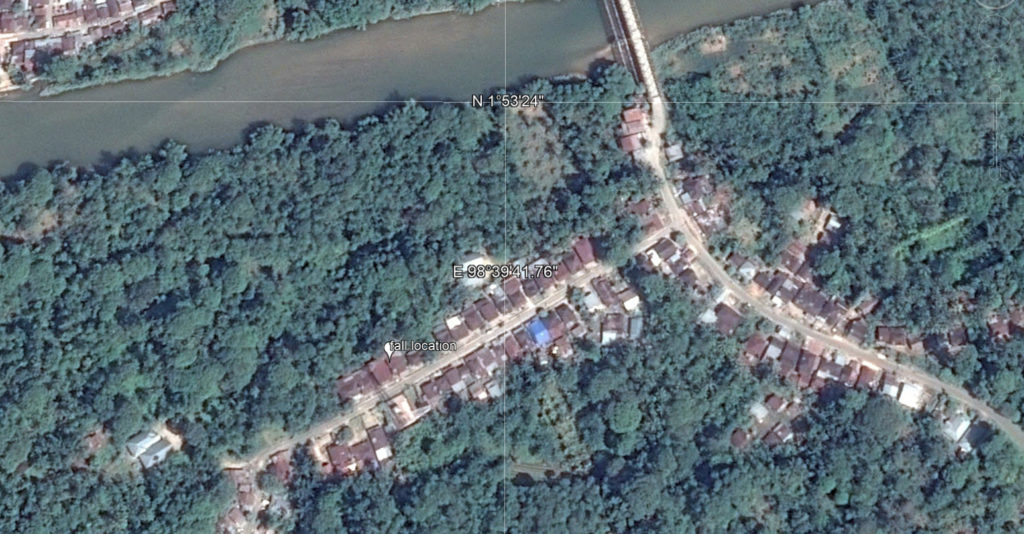
The exact fall location of the 2.4-kg mass in the Jalan (street) Aek Badan in the hamlet Sitahan Barat in Pasar Onan Hurlang, Kolang, Tapanuli Tengah. Up is north.

A meteorite fragment, most likely from the rice field, at the Arizona State University. Photo: Meenakshi Wadhwa
The 28.15-gram specimen
Fragments in a Satahi Nauli rice field (~250-350 grams)
The video below is the one Josua Hutagalung was referring to when he spoke about a find in a rice field about one kilometre from his home.
Two Batak men digging out fragments (~250-350 grams) of the meteorite specimen from the deep muddy soil of the Satahi Nauli rice field, ~793 metres away from the fall site of the 2.4-kg mass in hamlet Sitahan Barat. Unfortunately, the specimen crumbled into many small fragments when being touched during the excavation. The elderly farmer, who can be seen on the right at the beginning of the video, is a witness of the meteorite fall into the rice field. He heard the detonation boom and says that he heard sounds which he describes with the word ‘Marngongos’ which describes a sound like the whistling whoosh of an artillery shell. Then he saw the meteorite hit the rice field in front of him, ejecting mud into the air. The sound he heard during the impact is referred to with the expression ‘malabab’, a sound similar to a coconut hitting the ground. He immediately went to the fall site and marked it with a bamboo stick. Then he went away to tell Erick Sinaga, who had been in his garage at the time of the fall, to come and have a look. Erick Sinaga started to record the video shortly after the fall of the meteorite, probably between 4.45 p.m. and 5 p.m.. Video: Erick Sinaga (live broadcast on 1 August)
Scientific articles, papers and abstracts
V. H. Hoffmann
52nd Lunar and Planetary Science Conference (2021), Abstract #2458
The Bulk Mineralogy and Water Contents of the Carbonaceous Chondrite Falls Kolang and Tarda
A. J. King
52nd Lunar and Planetary Science Conference (2021), Abstract #1909
Media
Video: : Smart News Tapanuli (3 August 2020)
Video: tvOneNews (3 August 2020)
Video: thomsonpasaribu pasaribu (3 August 2020)
Video: thomsonpasaribu pasaribu (4 August 2020)
Video: Buletin iNews Pagi, iNews TV/Raymond (5 August 2020)
Video: daboribo_Kolang (5 August 2020)

